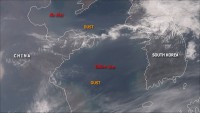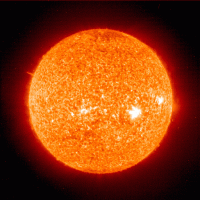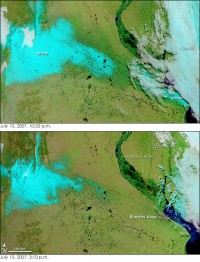Jul 23, 2007
Huge Dust Plumes From China Cause Changes in Climate
By Robert Lee Hotz, Wall Street Journal Online
One tainted export from China can’t be avoided in North America—air. An outpouring of dust layered with man-made sulfates, smog, industrial fumes, carbon grit and nitrates is crossing the Pacific Ocean on prevailing winds from booming Asian economies in plumes so vast they alter the climate. These rivers of polluted air can be wider than the Amazon and deeper than the Grand Canyon.

This MODIS satellite image shows a larg area of dust over the Bo Hai Bay and Yellow Sea extending into Korea. It is likely from the Gobi Desert.
“There are times when it covers the entire Pacific Ocean basin like a ribbon bent back and forth,” said atmospheric physicist V. Ramanathan at the Scripps Institution of Oceanography in La Jolla, Calif.
Over the Pacific itself, the plumes are seeding ocean clouds and spawning fiercer thunderstorms, researchers at Texas A&M University reported in the Proceedings of the National Academy of Sciences in March.
The influence of these plumes on climate is complex because they can have both a cooling and a warming effect, the scientists said. Scientists are convinced these plumes contain so many cooling sulfate particles that they may be masking half of the effect of global warming. The plumes may block more than 10% of the sunlight over the Pacific. But while the sulfates they carry lower temperatures by reflecting sunlight, the soot they contain absorbs solar heat, thus warming the planet.
See full story here.
Jul 20, 2007
Record Cold June in Australia in Post 1950 period
Australian Bureau of Meteorology June Summary
June 2007 was the coldest June recorded in Australia in the post?1950 period. It was also a notably wet month in most of northern Australia, as well as along many parts of the east coast. A number of unseasonable cloudbands affected the tropics, and the month was also notable for four major east coast lows forming off the coast of New South Wales and eastern Victoria during the month, bringing heavy rain to much of the region.
Maximum temperatures were particularly low in the tropics due to the influence of increased cloud cover, with both Queensland (anomaly ?3.01°C) and the Northern Territory (anomaly ?3.40°C) breaking regional records by substantial margins. There was an especially exceptional cold episode from 17?22 June which saw vast areas of tropical Queensland and the NT experienced their coldest day on record, with single-digit maxima as far north as Tennant Creek (8.0°C) and Mount Isa (9.4°C). It was also unusually cold further south in Queensland with a state record low maximum for June (4.9°C) set at Applethorpe. See full report here.
The cold has continued into July with new records set. See Queensland breaks cold weather record.
Jul 19, 2007
An Interview With Nigel Calder
London Book Review.com
Nigel Calder, former editor of The New Scientist and author of innumerable books and articles on science, including The Chilling Stars, in conversation with Pan Pantziarka.
London Book Review:
How do you respond to the paper by Lockwood and Froehlich, which claims to comprehensively ‘settle the debate’ on the cosmic ray hypothesis you describe in The Chilling Stars?
Nigel Calder:
How often we’ve heard it before, that the debate has been settled! But this is an interesting case because these scientists accept that the Sun has played a big part in climate change over hundreds and thousands of years, just as we explain in the book. They even allow that it was involved in the warming in much of the 20th Century. And when Lockwood and Froehlich go on to say that the intensification of solar activity seen in the past hundred years has now ended, we don’t disagree with that. We part company only when they say that temperatures have gone on shooting up, so that the recent rise can’t have anything to do with the Sun, or with cosmic rays modulated by the Sun. In reality global temperatures have stopped rising. Data for both the surface and the lower air show no warming since 1999. That makes no sense by the hypothesis of global warming driven mainly by CO2, because the amount of CO2 in the air has gone on increasing. But the fact that the Sun is beginning to neglect its climatic duty—of batting away the cosmic rays that come from ‘the chilling stars’—fits beautifully with this apparent end of global warming.
Read whole interview here.
Jul 16, 2007
The Truth Is, We Can’t Ignore the Sun
By David Whitehouse
According to the headlines last week, the sun is not to blame for recent global warming: mankind and fossil fuels are. So Al Gore is correct when he said, “the scientific data is in. There is no more debate.” Of that the evangelical BBC had no doubt. There was an air of triumphalism in its coverage of the report by the Royal Society.

But there is a deeper and more worrying issue. Last week’s research is a simple piece of science and fundamentally flawed. Nobody looked beyond the hype; if they had, they would have reached a different conclusion. The report argues that while the sun had a significant effect on climate during most of the 20th century, its influence is currently dwarfed by human effects. It says that all known solar influences since about 1990 are downward and because global temperature has increased since then, the sun is not responsible.
No. The research could prove the contrary. Using the global temperature data endorsed by the Inter-national Panel on Climate Change, one can reach a completely different conclusion. Looking at annual global temperatures, it is apparent that the last decade shows no warming trend and recent successive annual global temperatures are well within each year’s measurement errors. Statistically the world’s temperature is flat. The world certainly warmed between 1975 and 1998, but in the past 10 years it has not been increasing at the rate it did.
My own view on the theory that greenhouse gases are driving climate change is that it is a good working hypothesis - but, because I have studied the sun, I am not completely convinced. The sun is by far the single most powerful driving force on our climate, and the fact is we do not understand how it affects us as much as some think we do. So look on the BBC and Al Gore with scepticism. A scientist’s first allegiance should not be to computer models or political spin but to the data: that shows the science is not settled. See full story here.
Jul 12, 2007
NASA Photos of the Argentina Snowfall
NASA GSFC
For the first time since 1918, snow fell in Buenos Aires, Argentina, late on July 9, 2007, reported the Associated Press. The snow was still there the next morning when the Moderate Resolution Imaging Spectroradiometer (MODIS) flew over on NASA’s Terra satellite at 10:55 a.m. local time. This false-color image, made with a combination of infrared and visible light, reveals the snow beneath the clouds that still hang over the coast. In this image, snow is pale turquoise blue, while clouds are lighter blue and white. Not only does the snow blanket Buenos Aires, but it also covers a broad section of the highlands to the west.

The snow was short-lived, however. By the time MODIS flew over on the Aqua satellite at 3:10 p.m. local time, both snow and clouds were gone from Buenos Aires, the cement-colored area on the southern bank of the Rio de la Plata in the lower image. The snow had also receded significantly in the higher elevations. The snow fell during a long cold snap that claimed 23 lives and caused an energy crisis, said the Associated Press.
True-color, photo-like images of the snow in Argentina are available from the MODIS Rapid Response System. NASA images courtesy the MODIS Rapid Response Team at NASA GSFC. See Argentina Snowfall from Satellite
|





